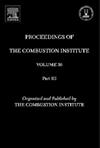Ammonia as a fuel has sparked significant interest in the combustion community. Although, using ammonia has a lot of advantages including no carbon emissions, ammonia-air flames are characterized as thick flames with low flame speeds. It is important to understand the flame structure to know the combustion process better. Flame thickness is an important property of the flame which characterizes the reactivity of the flame. Identifying the preheat zone is necessary to determine the fresh gas surface which is used to determine flame speed. Also, understanding the behavior of the important species emitted helps to demonstrate the reaction pathway which may be implemented in chemical kinetics schemes. Further, it is interesting to know the effect of curvature on the emission of excited species which gives direct knowledge on the influence of curvature on the flame reactivity. It was seen that the change in reactivity was manifested as a change in thickness of the species. The experiments presented here were performed on a Bunsen burner at atmospheric conditions. The laminar flame speeds have been evaluated over a range of equivalence ratios by choosing the isotherm as specified by the definition of the flame speed which are slightly higher than the values obtained from the literature. Chemiluminescence from NH* and NH2* was studied for different equivalence ratios. A 1D simulation performed in Chemkin-Pro-was used to compare the behavior of the counterpart non-excited species. This comparison helps to correlate excited and non-excited species and also to define the structure of the ammonia-air flame. Both NH* and NH2* have been determined as heat release rate markers.


